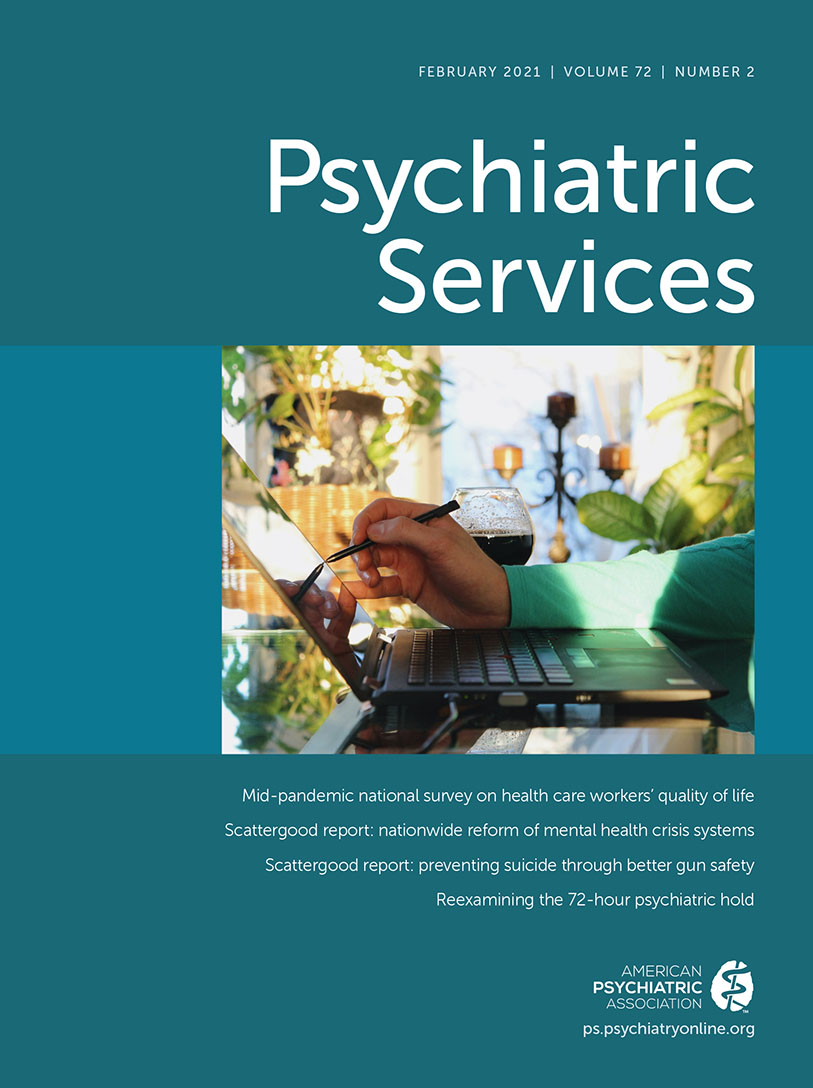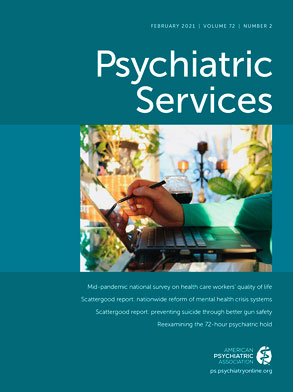Populations with mental illness remain at a considerable disadvantage in oral health outcomes across the world (
1). Emerging data correlate poor oral health with systemic medical comorbid conditions and associated increased mortality rates (
2). Oral diseases have been associated with numerous inflammatory and infectious diseases and may directly lead to bacterial colonization, which may cause bacteremia and chronic inflammation of multiple organ systems (
3). Poor oral health status among patients with mental illness is an important cause of the 25-year lower life expectancy for people with mental illness, compared with the general population (
4–
6).
Evidence suggests a bidirectional relationship between oral health and mental health (
7,
8). Poor oral health negatively affects social functioning because of its effect on smiling, eating, speaking, psychological well-being, self-esteem, self-confidence, and quality of life (
9,
10). Additionally, persons with mental illness are more likely than those in the general population to experience adverse oral health and to require more dental interventions (
8). A systematic review found that individuals with serious mental illness are 2.8 times more likely than those in the general public to lose teeth and to have more decayed, missing, and filled teeth (
1). Increased dental decay and tooth loss are common among persons with anxiety and depressive disorders, and those with eating disorders often have significantly more dental erosion and decay than those without eating disorders (
8,
11).
Individuals with mental illness experience several risk factors that increase the prevalence of oral health problems, including adverse effects of prescribed psychotropic medications; comorbid substance use, including tobacco use; and poor diet (
12,
13). Previous studies have reported barriers to oral health care, such as the cost of care, lack of insurance, transportation barriers, lack of time to seek dental services, and dental anxiety (
14–
16). Additional barriers, including the oral health team’s attitudes toward and knowledge of mental illness and the severity of mental illness, also impede access to care among persons with mental illness (
13,
17). Furthermore, lack of communication between psychiatrists and dentists, lack of knowledge of psychiatrists regarding oral health, and the reluctance of dentists to provide care to patients with mental illness are additional barriers (
18,
19). Facilitators of good oral health include interprofessional education, financial support and resources, and supportive policies, such as reimbursement of trained nondental health care providers to provide dental screenings, patient education, and fluoride varnish applications (
20).
Discussion
This study explored the views of patients, psychiatrists, and dentists about barriers to and facilitators of oral health care for persons with mental illness. Consistently, the patients, dentists, and psychiatrists stated that issues related to finances were the primary reason that patients did not seek dental care. Patients typically were seen by dentists only when they had pain or emergencies. They did not seek preventive or follow-up dental care because of the associated costs. This finding highlights factors that may explain the lower use of dental care by most of the participating patients: socioeconomic challenges, higher costs associated with more serious dental disease, unaffordable private dental insurance plans, and a paucity of community dentists accepting Medicaid (
28,
29). The finding is consistent with those in the literature suggesting that financial hardship often prevents individuals from accessing oral health care, because payment for these services is mostly by fee-for-service arrangements (
30–
33).
The barriers to accessing dental care access that are related to financial burden can partly be addressed by the expansion of state and federal programs that provide incentives for dentists to establish programs in underserved areas to provide treatment to vulnerable populations, by integrating multidisciplinary collaborations within existing health systems and by increasing provision of financial assistance programs to selected uninsured or underinsured patients. Given the symbiotic relationships among mental, general medical, and oral health outcomes, this barrier also indicates a need for effective liaisons between all medical providers, including psychiatrists and dentists working within publicly funded organizations (
34).
The dentists and patients identified anxiety and fear related to receiving dental care as the second most pressing barrier. Higher psychiatric burden has been found to be associated with heightened dental anxiety, increased fear-related reactions associated with dental injections, and insufficient access to dental treatments (
35). Anxiety related to dental care among patients can also cause higher provider stress, which may lead dentists to refuse care provision, especially if dental training does not address providing care to persons with mental illness (
36). Most of the dentists reported the importance of using anxiety reduction techniques to decrease patient and provider stress, and all dentists stated that they felt confident in treating these patients. It is noteworthy that when the dentists commented on the fear of treating patients with mental illness, in all cases they were referring to their dentist colleagues. None of the dentists in our study reported reluctance or fear to treat patients with mental illness. However, this finding may be attributable to convenience sampling or social desirability bias. We attempted to counteract this bias by using nominative technique (
37)—that is, asking dentists to comment on the perceived attitudes and fears of their colleagues who also treat patients with mental illness.
The patients in this study did not report their anxiety about dental care or previous negative experiences with such care to their psychiatrist. The psychiatrists said that they did not discuss any facilitating factors in addressing dental anxiety with their patients. This missed opportunity for communication may be related to inadequate recognition of anxiety related to dental care by psychiatrists, mediated by a lack of collaboration between existing dental and psychiatric care delivery systems. Additionally, during clinic visits, psychiatrists may put more emphasis on patients’ presenting symptoms related to their psychiatric disorders. Although not discussed by the psychiatrists in this study, it is possible that because dental anxiety was described more specifically in relation to dental procedures, psychiatrists may perceive it as a manifestation of anxiety about dental care and chairside-triggered phobia also seen among persons without mental illness. The association between dental treatment–related anxiety and psychiatric disorders may become less challenging to understand with better partnerships between psychiatric and dental providers.
Participants specifically identified a lack of screening by psychiatrists or general practitioners as a barrier to oral health care. Psychiatrists reported that they do not screen for dental issues, and the dentists reported that in their experience, nor do general health care providers. As reasons for not screening, psychiatrists reported lack of time and training and a concern that screening will not make a difference (
Table 2). The psychiatrists’ concern about the low impact of screening may be related to a regional lack of resources, inadequate access to dental care, challenging insurance-related requirements, patients’ reluctance to engage in dental care, restriction of focus to presenting symptoms because of time constraints, and virtually nonexistent referral procedures. Patients reported that being regularly directed or reminded to attend to their teeth was something they specifically needed. This need underscores that clinicians and policy makers should emphasize that comorbid dental diseases should receive attention and priority on par with those for comorbid psychiatric and general medical disorders. Increasing partnerships between nondental and dental providers may help patients by bridging current health care gaps and may improve quality of life among persons with psychiatric disorders (
38). Inclusion of standard checklists that general medical and psychiatric providers can administer may help identify patients who need preventive care or dental treatments.
Additionally, a brief semistructured oral health assessment can be included when assessing adverse effects related to prescribed psychiatric medications, particularly iatrogenic dry mouth, and when asking patients about lifestyle modifications, tobacco smoking, and other substance use history. Similar assessments can be performed during inpatient care, and dental follow-ups can be scheduled during discharge planning. Inclusion of screening, brief intervention, and early dental referral will help improve oral, psychiatric, and general medical outcomes among patients (
39,
40).
The health providers reported gaps in their education. Specifically, dentists reported not receiving training in mental health issues, and psychiatrists reported not receiving training about the role of oral health in mental health and the need to screen for oral diseases. Both psychiatrists and dentists believed that patients’ low education levels and lack of knowledge about the importance of oral health affect their seeking dental care. Such deficits in training and education can be addressed by including in patient assessments a psychiatric history by dentists and a dental history by psychiatrists and other medical providers. Approved agencies could offer continuing dental or medical education credits toward annual requirements, educating and motivating providers to conduct screening and brief interventions and to refer patients as needed. Mental health providers are interested in oral health education, which has been confirmed by recent work indicating their willingness to learn more and perform oral health screenings for their patients (
23). Dentists have also expressed a need to receive more training about mental illness (
23).
Study participants viewed several factors as likely to increase utilization of preventive oral health services, including sliding fee scales, legislation for the expansion of dental benefits for adult recipients of Medicaid, and access to other types of dental insurance. As discussed, pain was considered a facilitator to seeking acute dental care but not to seeking preventive dental care. Patients stated that regular communication from psychiatrists and periodic reminders from dentists might help increase dental preventive care. Additionally, the move toward interprofessional education was seen as a potential facilitator of dental treatment, because it increases cross-training and communication.
The psychiatrists and dentists discussed the stigma of mental illness as a barrier to seeking oral health care, but they did not suggest how to overcome this stigma. It is noteworthy that the providers had the same perception about mental illness stigma that is embraced by the general public. This finding raises some public health implications, because such provider attitudes may implicitly affect their patients’ care. It appears that many senior psychiatrists or faculty dentists may have stigmatizing attitudes and beliefs about mental illness and treatment from previous decades. Stigma becomes challenging and important because senior psychiatrists and faculty dentists may relay their concerns to students and resident trainees. None of the patients mentioned stigma or the feeling of being judged in the dental office as a barrier. The patients’ perceptions regarding improving attitudes toward persons with mental illness and associated stigma are encouraging. The positive attitude change toward patients with mental illness may be a result of antistigma campaigns and greater awareness, understanding, and attention to mental health in the United States.
Finally, patients and dentists reported that dentists did not ask patients about their psychiatric diagnosis, even when it was disclosed in the patients’ medical history. Including pertinent details regarding mental illness or anxiety in shared electronic health records, although challenging to implement, may help increase interactions among various providers and contribute to a more efficient triaging process. Investments in grassroots programs by health care agencies to raise levels of awareness regarding psychological health in communities and educational institutions and among health care providers may help eliminate misinformation, misapprehensions, and stereotypes associated with mental illness and may help reduce stigma among members of the public and health care professionals.
Some limitations of the study should be noted. Convenience sampling was used for recruitment, which may have selection biases. Providers who were interviewed worked in an academic setting, and they may be different from providers in other practice environments. Although we pretested our interview guides before implementation, important topics may have been omitted; however, we note that no new topics emerged in the analysis. The patients were recruited from a mental health clinic, which limits the generalizability of the findings, because patients not engaged in mental health services did not participate in this study. Because all participants lived in eastern North Carolina, the results may not be generalizable to individuals residing in other areas of the United States.

